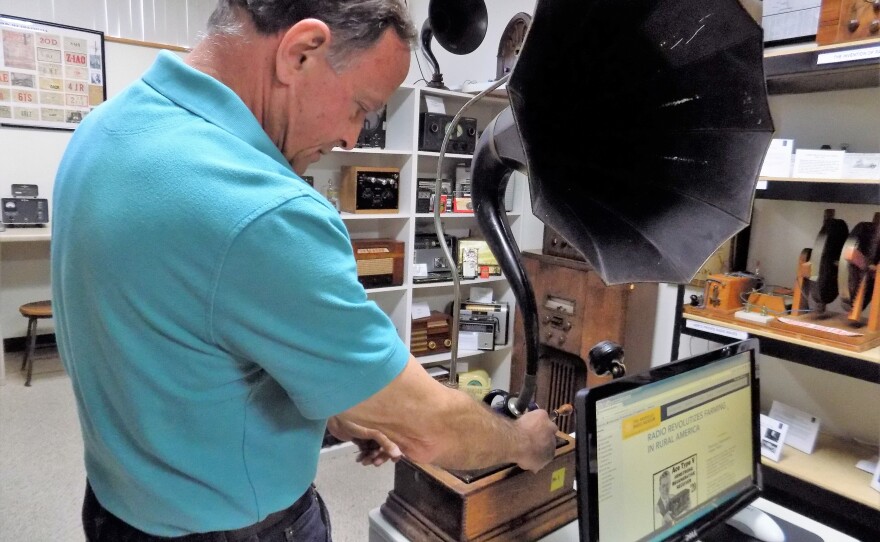When you think of tourist attractions here in Western North Carolina, places like the Biltmore House, the Blue Ridge Parkway come to mind. But if you hang around here long enough, you eventually learn about the lesser known spots, including one hidden in the halls of a Community College.
Tucked away in a quiet hall on the AB Tech College Campus is a small museum full of history – for the ear. There is vintage music.
And historical moments – like this live account of the Hindenburg disaster.
“It burst into flames, it’s crashing, oh my get out of the way.”
(Sound of Morse Code tapping)
And all sorts of beeps and buzzes.
“This is an old Morse code practice machine that people would use to practice their skills deciphering Morse code as it came down the telegraph wires or over the radio,” says Stuart Smolkin, a volunteer curator with the Asheville Radio Museum, located in the Department of Engineering and Applied Sciences
“You are dead center in the souths largest collection of antique radio equipment,” says Smolkin.
HC: How did it land here in Western North Carolina?
“It landed here due to the dedicated amateur radio operators who started this radio collection about 2001 and they put out the word to other amateur operators in the area and that led to the collection you see here today,” says Smolkin.
A collection that traces the history of radio starting with early days of spark gap transmitter.
(beep beep beep)
“It generates a spark, the spark generates the radio wave, the short is a ‘dot’ and the long is a ‘dash’ and that’s how radio transmission got started,” says Smolkin.
Along with the ears, there are treats for the eyes, vintage radios line one side of the room, like sculptures in an art museum.
“The earliest radio that came out were made by a company called Atwater Kent, which was the gentleman’s name and he thought that his components were so beautiful, he didn’t put them in a case he put, but left the innards in a case for everybody to see, because they are so beautiful and they are. In fact, let’s take a look at this radio here, which is from the mid 1020’s. If you can picture the beautiful dials, look inside, those gorgeous vacuum tubes, that look like shiny mirrors and such, this was indeed a work of art.”
Next to the beautiful, is the practical, a section on the impact of radio on rural America, with a focus on farmers.
“The radio in 1920s was internet of its day for farmers,” says Smolkin, “They could get crop reports, pricing reports, when to bring crop to market, advance weather reports, they could get training from the USDA on how to manage diseases with their animals, so the information superhighway of the 1920s is the best way to describe it.
And at core of this radio wave wonder room is a whole section dedicated to amateur radio, including a working amateur radio station where among others things, you can tune in to the international space station.
“November Alpha One.”
“The amazing thing about amateur radio, is that even though it started back in the early 1900’s, you think interest has faded because of cell phones and the internet and such, yet the number of amateur operators in this country continues to grow and is about to hit 800 thousand licensed operators in the United States, there is more than 20 thousand in NC alone.” says Smolkin.
The museum even offers ham operator courses. It’s a radio treasure trove, just off the beaten tourist track, At the Asheville Radio Museum, I’m Helen Chickering.
The public is invited to join the Asheville Radio Museum guys on Saturday, April 29th from 3:00 – 5:00 PM at the Asheville Museum of Science for an introductory workshop to learn all about radio! Many interesting items will be there for you to see, including Morse code charts, telegraph keys, old vacuum tubes used before the transistor and integrated circuits were invented, along with hundred year old radios used on family farms. Hear famous radio broadcasts from those early days!
You’ll also learn all about amateur (“ham”) radio – the fun things hams do, the technology, how hams help in emergencies, and how modern hams do exciting things today with the internet, satellites and even talking to astronauts. Learn how you can become a licensed amateur radio operator with your own equipment.
This workshop is geared towards students age 12 and older, and all interested adults.







